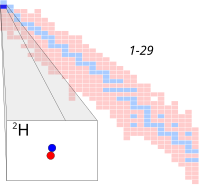
Photo from wikipedia
The hydrogen (H) isotope deuterium (D) has attracted special interest for the manufacture of silicon (Si) semiconductors, Si microchips, and optical fibers, as well as for the synthesis of isotopically… Click to show full abstract
The hydrogen (H) isotope deuterium (D) has attracted special interest for the manufacture of silicon (Si) semiconductors, Si microchips, and optical fibers, as well as for the synthesis of isotopically labeled compounds. However, the efficient production of D or H deuteride in a controlled manner is challenging, and rational H isotope enrichment protocols are still lacking. Here, we demonstrate a highly efficient exchange reaction from H to D on the surface of nanocrystalline Si (n-Si). Fourfold enrichment of D termination was successfully achieved by dipping n-Si into a dilute D solution. By determining the surface-localized vibrational modes for H- and D-terminated n-Si using inelastic neutron scattering spectroscopy, we found that the physical mechanism responsible for this enrichment originates from the difference in the zero-point oscillation energies and entropies of the surface-localized vibrations. Theoretically, the extent of enrichment could be greatly enhanced (\ensuremath{\sim}15 times) using a gas-phase reaction. This enrichment protocol, which avoids the use of precious metal catalysts, opens the way for sustainable H-to-heavy H exchange reactions.
Journal Title: Physical Review Materials
Year Published: 2021
Link to full text (if available)
Share on Social Media: Sign Up to like & get
recommendations!